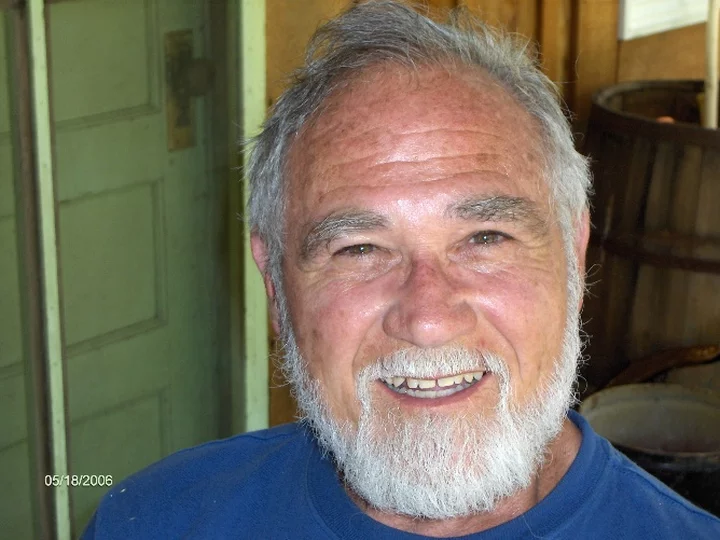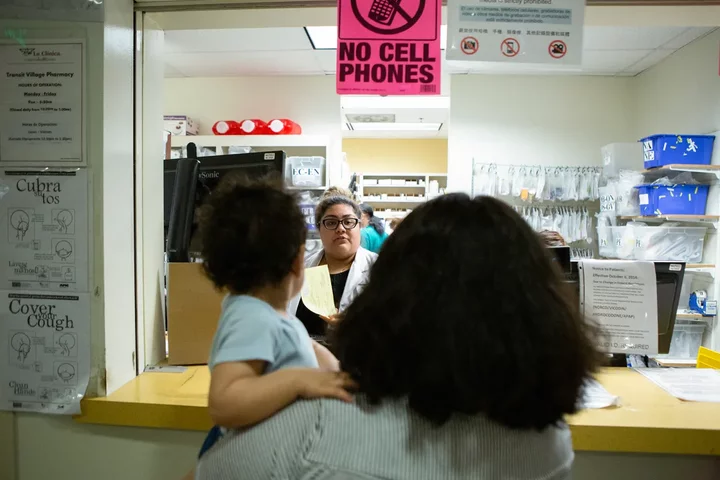OBITUARY: Byron ‘Mike’ Chamberlain, 1935-2024
LoCO Staff / Tuesday, Feb. 4, 2025 @ 6:56 a.m. / Obits
The kind and loving Mike Chamberlain passed away, unexpectedly, due to complications from a fall. His great spirit and kind smile will be missed by those who knew and loved him. He lived a free and adventurous, fiercely independent, life.
Born to Frank and Ruth Chamberlain, he and his brother, Larry, were raised in El Segundo. He attended UCLA, the University of Alaska and the University of Hawaii, earning a degree in marine biology and a teaching credential. Later he was drafted into the Army, where he worked as a tank technician in Texas. During his college years, Mike was an avid sportsman. In Alaska he joined the hockey team, having never ice skated in his life, so the coach had him practice with his skates unlaced. Mike spent a lot of time diving, spear fishing and beach-combing, and as a lifeguard, he spent time teaching children in Watts how to swim
While attending UH he met and married Katherine Piltz. Soon after having a son, they moved from Hawaii back to So. Cal. where their daughter was born. While teaching at Airport Jr. High, Mike camped with a group of students and his small children on a Catalina beach for the summer. In 1969 the family moved to Humboldt County, living around the Eureka area. He continued teaching at Jacobs Jr. High and occasionally at Zane and Winship. After his divorce, he raised his son Barry in Eureka.
In the late seventies Mike retired from teaching and did handyman work in the winters and during the summers he was dredging for gold in places like Denny, Salmon River, Hiouchi and Cecilville. He relished the simple lifestyle of camping. Extensively exploring every forest service road in Humboldt and Trinity County, where his shiny karma somehow kept him safe. Many of these adventures were shared with his husky Tok, along with intermittent stops to tune or work on his VW square-back.
Mike pursued many endeavors throughout his years after teaching. He started Aurora B Photography and had a darkroom in his bathroom where he printed pictures of the flora and particularly mushrooms of this area. We will be sorting through his slides for decades. He collected copious amounts of driftwood from the jetties, a place he visited frequently. Using these pieces to craft driftwood art, furniture and turned bowls. Much of the wood went to build a greenhouse, and additions on his garage. Early in the 1980s, Mike got a pilot’s license and plane to make the visits to his parents, in Paradise, an easier commute. He also flew up to Canada with his school friend, Gene, to help build a cabin.
Mike gave his children the love of the outdoors, teaching them how to backpack, ski, fish, camp and hunt. Some of his favorite places were out of the way. He loved swinging bridge, the jetties and Nordheimer Creek on the Salmon River, where he spent many summers camping there by the little lake. We would go to Swimmer’s Delight before it was a park. A day drive might be the Lost Coast, just to get out and enjoy the beauty of Humboldt. Long drives were a Chamberlain family tradition. In his later years he had a faithful loving orange tabby cat named Max. Those two did everything around the house together.
His mother, Ruth, moved closer in her later years and Mike was there for her.
Mike was preceded in death by his father Frank, mother Ruth and brother Larry Chamberlain. He is survived by his son Barry and daughter Kim Chamberlain. His granddaughter Nicole (Todd) Brown and great granddaughter Amara Brown. Thank you to all his friends — Raedelle, Barbara, Howie, Steve and Vicki — who helped him through his later years and Ayres Funeral home for after-life particulars.
For anyone interested in sending Mike on his way, there will be a memorial located at a private residence. The date is March 15, Saturday at 1 p.m. Please contact Kim at idowatsu@sbcglobal.net for details on how to attend.
He lived a full life and as a biologist was distraught at the plight of how fast global warming had advanced in his later years. In lieu of any donation please consider how you could help do your part in decreasing the progression of global warming. It is as simple as bringing your coffee cup along to fill, bring grocery bags into the store, send gently used items to a thrift store for someone to use; so many simple ways…
###
The obituary above was submitted on behalf of Mike Chamberlain’s loved ones. The Lost Coast Outpost runs obituaries of Humboldt County residents at no charge. See guidelines here. Email news@lostcoastoutpost.com.
BOOKED
Yesterday: 8 felonies, 6 misdemeanors, 0 infractions
JUDGED
Humboldt County Superior Court Calendar: Friday, Jan. 2
CHP REPORTS
Us101 N / Scotia Ofr (HM office): Trfc Collision-Unkn Inj
ELSEWHERE
RHBB: Driver Trapped After Seizure Reportedly Leads to Crash at Fourth and I Streets in Eureka
Mad River Union: APD: Arcata declares State of Emergency
Willow Creek is Getting a Bigfoot-Themed Skate Park This Summer. It Took a Decade, Hundreds of Meetings and a Couple Million Dollars. Here’s How it Happened.
Dezmond Remington / Monday, Feb. 3, 2025 @ 4:12 p.m. / Local Government , LoCO Sports!
Concept art of the Bigfoot Bowl. Photo courtesy of Rich Conklin.
Good skaters make it look easy.
Saying that about supremely talented athletes is a cliche, but people say it because it’s true. The best move like liquid, devoid of any obvious effort. They jump over obstacles or through them or — why not? — hit them intentionally. The board is a partner, co-equal in a ballet that can be slow or fast or FAST and could be here, there, anywhere there is ground to ride on or air to soar through. A good skater is a dancer with total freedom. Even a complete novice or onlooker can see how they value that, so it’s striking when any of them decide to sacrifice even a small part of it.
This summer, a Bigfoot-themed skatepark opens in Willow Creek. To one of those novices or onlookers it will appear out of nowhere, but that’s only happening after some of those good skaters have voluntarily spent years and countless hours of toil embedding themselves in government, working from the ground up to make it happen.
Riley Morrison, a Willow Creek-based cannabis grower and lifelong skater, has spent huge chunks of the last 10 years attempting to build it. He moved there in 2010 from Marin, though he’s originally from Atlanta.
Morrison is a serious skater. He’s got a halfpipe on his farm and co-owns Rampart, an indoor skatepark in Arcata. On road trips, he likes to stop in towns that have skateparks and get some exercise in with his kids, who also skate, snowboard and surf with him.
The planned upgrades to Veteran’s Park.
“I’ve always tried to stay relevant as a rad dad and provide a good outlet for these kids to enjoy themselves,” Morrison said.
Skateboarding is a simple sport to start doing. All it takes is “your brother’s old, beat-up board and his shoes,” as Morrison put it. He saw a need for a skatepark in Willow Creek when he saw how Willow Creek’s soccer team for kids nine years old and younger would get demolished when they played; all the more urban teams were actually made up of nine-year-olds, and their team would have athletes as young as five playing because they barely had enough players to flesh out a team. It wasn’t fair to pit a rural town against fully-manned teams with modern training facilities.
“[Some of those five-year-olds], we just make them get in the car and go to the game,” Morrison said. “So the kids grow up with this attitude that sports and recreation isn’t for them.”
According to Morrison, Willow Creek and the surrounding area also has a dire need for more recreational activities that young people enjoy.
“It’s a safe space where kids can go,” Morrison said, nodding while he sipped a coffee, warm in a Dead and Company hoodie the exact shade of green as his eyes. “Skateboarding saves lives! It’s the truth, you know. And to create a space like that in Willow Creek, that has accessibility for the upriver community — for the tribe, that’s a huge need. We just don’t have a space where kids can be kids. Otherwise, they get into trouble. And there’s plenty of that.”
In 2015, Morrison decided it was time to do something about it, but building a skatepark alone is impossible. None of the local nonprofits wanted to attach their names to the project, due to the funding it would take and the difficulty involved. Fortunately for him, Charlie Caldwell, director of the Humboldt Skatepark Collective, was willing to help.
Caldwell, 63, is a retired PG&E project manager. He started skating when he was 7 years old.
“It’s freedom,” Caldwell said. “Even at 60, almost 64, when I get on a board, I start going into 12-year-old mode.”
Caldwell was instrumental in getting the first phase of the 5,000 square foot McKinleyville skatepark finished, though he won’t be completely satisfied until the last 15,000 square feet are done once they fundraise another $250,000.
Building a skatepark is a monumental task. It took 20 years to build even the first part of the McKinleyville skatepark; the Great Pyramid of Giza took 26. Securing the funding, getting the permits, finding a contractor and keeping the community engaged all throw up enough hurdles for a dozen horse races.
Caldwell said the most important thing he did was share a roadmap for Morrison to follow. By the time he started working on the McKinleyville skatepark, no one remembered how the parks in Arcata or Eureka were built.
“What I mostly do is encourage and give,” Caldwell said. “Because I’m a project manager, I keep everything organized and laid out, so when someone says ‘Hey, I need to do this,’ I go, ‘Here’s everything!’ It’s hugely complicated, and I’ve already walked through it.”
Morrison spent hours working with the Willow Creek Community Services District attempting to come up with something. He and Caldwell went to every meeting the CSD held for years. Eventually, they decided to work the park into a larger improvement planned for Veteran’s Park, though the Willow Creek CSD still wasn’t committed to signing a memorandum of understanding.
In 2019, four years after Morrison first started trying to build a skatepark, he and Caldwell decided to go after $4.2 million of California’s Proposition 68 funding. They had money from two skating events they hosted, and spent $20,000 on a grant writer, saving a few grand by doing all of the community outreach themselves. Over 700 people responded to their survey; only 1,500 live in Willow Creek. The proposal would include dozens of upgrades to Veteran’s Park besides just a skatepark — street lights, a better baseball diamond and a concession stand, to name a few.
They didn’t get the grant, and by this point Morrison was over dealing with the CSD, who were proving hard to work with. He ran for election in 2020 and beat the incumbent after seven mail-in votes were counted, a month and a half after Morrison had already conceded.
“This is an institutional board that is very comfortable with living in their retirement community of Willow Creek,” Morrison said, “And trust me, they want the best for the kids, but there was nothing going on with the CSD. They aren’t developing recreation. They’re not developing their assets.”
The cannabis association didn’t help Morrison either. He said he often felt stigmatized for being a grower, and said it could be hard overcoming entrenched community bias.
“There were times in the last 15 years where you kept your head low,” Morrison said. “You would go to the gas station, and then you go back. We were not accepted as a community out there. [But] since the industry has collapsed, I think everybody can appreciate what the struggle was and release their critical biases.”
Morrison and the Humboldt Skatepark Collective tried to secure another $4.2 million in Prop 68 funds in 2020, but again they failed.
They decided to try again in 2021, this time for only $1.9 million. They cut the add-ons down to nine things instead of 14. But the biggest change was to the skatepark, which they decided to make Bigfoot-themed. Morrison credits former Arcata mayor and grant writer Susan Ornelas with the idea, although Ornelas told the Outpost that it was all Morrison.
“We needed a catch,” Ornelas said. “We needed something. And I was like, ‘Everyone loves Bigfoot! I don’t know anybody who doesn’t love Bigfoot, whether you believe in Bigfoot or not…I really let my inner Bigfoot out. I suppose I kind of went for it, did a painting of [Bigfoot on a skateboard], and included that in the grant proposal.”
That time, it worked.
Everyone involved in the process said that getting the funding is, by far, the hardest part of the process. The process wasn’t done yet, though — next came bidding for a contractor and a designer, which ended up going to Primary Concrete, the same company that built the McKinleyville skatepark.
Founder Rich Conklin said his design was inspired by the nearby Trinity River, with lots of blue-colored concrete and river textures. The final design should be around 8-10,000 square feet and, of course, is very Bigfoot-centric. Skaters will be able to glide over his toes. There will be a Bigfoot interpretive center and a Bigfoot water feature and a Bigfoot sculpture elsewhere in the park.
Conklin enjoys working on this project.
“The parks that are really special are the ones that have this grassroots undercurrent and that real sense of a community project,” Conklin said. “You’re like, ‘Man, these guys have been working so hard for years and years, and fundraising and red tape and meetings — all that stuff, and I just get to show up.”
Morrison is very excited for this project to be over. His goal was to see his kids skate in the park before they graduated high school. When he started trying to get it done, they were in elementary school. Now, they’re 14 and 16 years old.
Ten years to build a skatepark, from inception to delivery, is not a long time. Morrison attributes the success to timing and persistence, likening the process to building an airplane while you’re flying it.
Willow Creek’s electorate voted him in for another term on the CSD, but he’s eager to finish out his career in politics in a few years, stop growing weed someday and focus on his kids and skating.
“I don’t want to be in politics anymore,” Morrison said. “It’s like a Chinese finger trap…I look forward to the day I can stop growing weed and grow more vegetables. That’s how you’ll know I’m retired…The weed can come and go, but we got a skatepark. That concrete isn’t going anywhere.”
The Sheriff’s Office Would Like to Meet the Anonymous Artist Who Decorated Its Patrol Cars and the Jail Last Weekend
LoCO Staff / Monday, Feb. 3, 2025 @ 3:22 p.m. / Crime
Press release from the Humboldt County Sheriff’s Office:
On Jan. 25, Humboldt County Sheriff’s deputies were notified that a white male subject was observed on security surveillance vandalizing several patrol cars and the correctional facility building with a black paint pen. Deputies immediately searched the area but were unable to locate the suspect.
The Sheriff’s Office is asking for the public’s help in identifying the suspect, who is believed to be a white male adult in his 30s. He was last seen on Jan. 25 wearing a gray hoodie with blue jeans, and a backpack, walking northbound on 4th St.
Anyone with information about this case or related criminal activity is encouraged to call the Humboldt County Sheriff’s Office at (707) 445-7251 or the Sheriff’s Office Crime Tip line at (707) 268-2539.
This case is still under investigation.
Image: HCSO.
GRAMMY’D: Humboldt State Alum Picks Up Songwriting Gold Over the Weekend
Andrew Goff / Monday, Feb. 3, 2025 @ 1:30 p.m. / Our Culture
Once a part of the Humboldt family, always a part of the Humboldt family, is what we’re goin’ with. And so, LoCO adds to the chorus of those sending out congratulations to formerly local song slinger Melody Walker for snagging gold in the Best American Roots Song category at Sunday’s 2025 Grammy Awards show. Hooray, Melody!
It’s been a long time ‘a-comin’. The one-time Humboldt State University student (B.A. Music, 2008) will be familiar to faithful Humboldt music scene watchers for her time in local vocal groups AkaBella and WoMama. In the early ‘10s, she took her talents south to the Bay Area where she found success as the driving creative force behind the bluegrass group Front Country — who happen to have been highlighted in our old Humboldt Live Sessions feature, we’re proud to say.
Fast forward to today: Walker earned her golden honor due to her co-songwriting credit on the song “American Dreaming,” a which appears on the album Trail of Flowers by alternative country shooting star Sierra Ferrell. Allow yourself to tune into the “Dream” by firing up the clip below and remember: A song written by someone with Humboldt roots won a Grammy for Best American Roots Song. That’s worth rootin’ for.
PREVIOUSLY:
Demand for Immigration Legal Services Spikes at California Colleges
Delilah Brumer and Mercy Sosa / Monday, Feb. 3, 2025 @ 7:01 a.m. / Sacramento
Artwork created by students hangs on the walls at the Dream Resource Center at Pierce College in Woodland Hills near Los Angeles on Jan. 28, 2025. The DRC supports undocumented students, providing resources like free legal services, educational workshops, scholarship information, and more throughout their academic journey at the school. Photo by Alisha Jucevic for CalMatters.
As President Donald Trump begins his second term with a declaration of a national emergency at the southern border and a steadfast pledge of mass deportations, California’s colleges and universities have been holding workshops and partnering with legal service nonprofits to help undocumented students on their campuses stay in school.
Across the University of California and California State University systems, as well as at many California community college campuses, Dream resource centers support the state’s estimated 100,000 undocumented students and students from mixed-status families. An estimated 3.3 million Californians live in mixed-status households, according to data from Equity Research Institute, a USC research group. These centers assist students with filling out financial aid forms, referrals to nonprofit immigration law firms, access to mental health support, and provide spaces to bond, do schoolwork or take a break.
Several Dream center coordinators and their nonprofit legal partners said they have seen unprecedented demand for legal services from undocumented college students since Trump’s election victory in November. Legal service providers say their free consultations are booked for several months with students seeking to understand the level of risk of deportation faced by them and their families.
Student demand for immigration legal services skyrockets
It’s been tough for Carlos, a student at Sacramento State, to concentrate since Trump’s election win. News about Trump’s immigration and deportation plans on social media serve as a constant reminder of his undocumented status and risk of deportation under the new administration.
“I would try to write whatever paper I needed to, solve whatever equation I needed to, and for some reason, I just couldn’t do it,” Carlos said. “Those (election) results were just in the back of my mind.” CalMatters is only publishing Carlos’ first name at his request because he fears sharing his identity could lead to authorities targeting him for deportation.
“At the end of the day, how I cope is just like going to the center and being around the friends I’ve made there,” he said of Sacramento State’s Dreamer Resource Center.
Through workshops hosted by the center’s nonprofit legal partner, the Coalition for Humane Immigrant Rights, Carlos is able to turn fear into action. He’s learned about his due process rights and how to react if immigration enforcement officials show up at his door: remain silent, remain inside and call an immigration attorney as soon as possible. Immigration enforcement officers cannot legally enter your home unless they have a warrant, signed by a judge, with the correct name and address listed, legal service providers advise.
“There’s a lot of fear mongering out there. We want students to know that their education is available to them.”
— D’arcy Corwin, Dream Resource Center coordinator at Los Angeles Pierce College
A 2019 state law encouraged the designation of Dream resource liaisons at the state’s public colleges and universities, and many have created physical Dream centers on their campuses to help undocumented students navigate financial aid applications and connect them with free legal services. The state has since provided $52.2 million over five years to fund these centers and liaisons. California serves the greatest share of undocumented college students in the country, with the highest portion of those students attending one of the state’s 116 community colleges.
Since 2001, when lawmakers approved AB 540, undocumented students who attend a California high school for three years and graduate have been eligible to pay resident tuition at the state’s public colleges and universities. Resident tuition is significantly cheaper than non-resident tuition in each of the state’s three public higher education systems.

The Dream Resource Center at Pierce College in Woodland Hills near Los Angeles on Jan. 28, 2025. The DRC supports undocumented students virtually and in person, providing resources like free legal services, educational workshops, scholarship information, and more throughout their academic journey at the school. Photo by Alisha Jucevic for CalMatters
At the University of California, nonresident tuition is approximately $35,000 more per year than California residents pay. Nonresident students in the Cal State system pay an extra fee of $420 per semester unit, in addition to the standard $6,000 annual tuition. At California community colleges, resident tuition is $46 per unit, and nonresident tuition varies, but is typically at least five times that cost.
Although undocumented college students are ineligible for federal financial aid, many are able to apply for the state’s flagship financial aid program, the Cal Grant. These students must enroll at a California college and have a family income below the maximum threshold to apply through the California Dream Act Application. More than 35,000 undocumented students submit the application each year, but only about a third receive aid.
As the Dream Resource Center coordinator at Los Angeles Pierce College, D’arcy Corwin has been listening to her students’ fears — and “having their backs.” That’s meant connecting them with food programs and immigration lawyers, hosting events that teach self-advocacy and helping them fill out financial aid applications.
“There’s a lot of fear mongering out there,” Corwin said. “We want students to know that their education is available to them.”
Immigration experts have warned that those at the highest risk of deportation under the Trump administration are non-citizens who have had past convictions or other contact with the criminal justice system, as well as the 1.3 million people nationwide who have received final orders of removal.

Dream Resource Center Lead D’arcy Corwin at Pierce College in Woodland Hills near Los Angeles on Jan. 28, 2025. The Dream Resource Center supports undocumented students, providing resources like free legal services, educational workshops, scholarship information, and more throughout their academic journey at the school. Photo by Alisha Jucevic for CalMatters
After Trump’s election, Guillermo Metelin Bock, who leads the Undocumented Student Services program at Stanislaus State, says that the questions from students have transitioned from financial aid and college affordability to immigration policy. To get those questions answered, students at Stanislaus State have access to legal services through a partnership with Immigrant Legal Defense, a free legal service provider that partners with nine Cal State campuses and 34 community colleges in the Bay Area and Central Valley.
Many Cal State and community college Dream centers partner with nonprofits that provide free immigration law assistance, including the Coalition for Humane Immigrant Rights, the Central American Resource Center and Immigrant Legal Defense. Students at nine University of California campuses also have access to free legal support through the systemwide Immigrant Legal Service Center, housed at the UC Davis School of Law. These nonprofits and campus resources create a geographic patchwork of immigration legal help, serving students throughout California. With Trump’s threats of mass deportations, immigration legal nonprofits say the demand for their services has skyrocketed.
According to Geno Uyuni, a staff attorney at the nonprofit Central American Resource Center, which provides free immigration legal services to students at 20 colleges and universities, her consultations are currently booked through March. In those sessions, Uyuni works with undocumented students to explore their options for green cards, citizenship, work permits and other applications.
Uyuni said “the most heartbreaking cases” are the students who came to the U.S. as children, but who have no available path to citizenship. She is sometimes the first person to deliver the news that even if they attain a college degree, they will likely never be able to work legally in the United States.
“There’s a disconnection between how much California supports you to get through school, but then there is little support beyond that,” Uyuni said.


First: Dream Resource Center Lead D’arcy Corwin hangs up art created by students. Last: Corwin folds new “Know Your Rights” legal-tip handouts at the center at Pierce College in Woodland Hills near Los Angeles on Jan. 28, 2025. Photos by Alisha Jucevic for CalMatters
A growing number of college students are ineligible for protections like work authorization under the Deferred Action for Childhood Arrivals program or DACA, as only people who applied before 2017 are able to renew their status following attempts by the first Trump administration to end the program.
While the Trump administration has yet to announce any new attempts to end the program, the future of DACA remains in limbo. On Jan. 17 the 5th Circuit Court of Appeals upheld a lower U.S. district court ruling that found some protections for DACA recipients to be illegal. The ruling still allows for DACA recipients to renew their status if already approved, but no new DACA applications can be processed. The case is likely to be appealed to the Supreme Court.
Founding Co-Executive Director of Immigrant Legal Defense Barbara Pinto says their online booking system saw “the biggest spike I think we’ve seen since we started this project” shortly after the presidential election results were clear.
Between the election and Trump’s inauguration, Pinto’s team hustled to file green card applications and DACA renewals in anticipation that the processing times for applications will grow during a Trump administration. Although it is difficult for Pinto to gauge exactly what Trump’s plans are, she said that the president would have to undergo a legal process to terminate DACA, meaning that the program would most likely not be eradicated overnight.
“Trump says a lot of things, and sometimes they’re true and sometimes they are not, and sometimes he follows through, and sometimes he doesn’t,” Pinto said.
The state steps in to protect undocumented students
Immediately following his inauguration Jan. 20, Trump began rolling out executive orders cracking down on immigration. In addition to the national emergency declaration, Trump designated Mexican drug cartels as foreign terrorist organizations. He also issued an executive order trying to end birthright citizenship, despite its guarantee in the 14th Amendment of the U.S. Constitution. Twenty-two states, including California, are suing to challenge this attempt, and on Jan. 23 a federal judge temporarily blocked it from taking effect.
On Jan. 21, the Trump administration threw out policies dating back to 2011 limiting immigration agents from arresting undocumented people at sensitive locations, including churches and schools. In California, state law states that K-12 school officials do not have to allow immigration enforcement on campus without a judicial warrant. At the college and university level, the policies are less clear-cut, because parts of campuses are open to the public, while other areas, such as dorms, require a judicial warrant for immigration enforcement to enter.
“Criminals will no longer be able to hide in America’s schools and churches to avoid arrest,” the Department of Homeland Security said in a Jan. 21 statement. “The Trump Administration will not tie the hands of our brave law enforcement, and instead trusts them to use common sense.”
California lawmakers are working to resist Trump’s deportation plans, but there’s only so much they can do at the state level. State Attorney General Rob Bonta issued directives to California’s public colleges and universities, reminding them of existing state laws that limits them from assisting federal immigration enforcement.
Bonta also emphasized that California local law enforcement agencies, including campus police departments, are prohibited by a 2017 state law from “generally providing personal information… about an individual for immigration enforcement purposes, including, but not limited to, the individual’s home address or work address, unless that information is available to the public.”
Gov. Gavin Newsom and Democratic legislative leaders have agreed to set aside $50 million in state money to pay for the legal costs of fighting the Trump administration. Additionally, the current state Senate budget bill would allocate $10 million for legal service providers to support immigrants, as well as $15 million for legal support of “vulnerable persons,” including those at risk of deportation.
Since 2019, the state has allocated money to support the immigration legal service providers that partner with public colleges and universities, doling out a total of $2.9 million to the University of California, $42 million for the California State University and $50 million for the California community colleges. Gov. Gavin Newsom’s proposed 2025-26 state budget includes an allocation of $17.6 million to immigration legal services for public higher education institutions, along with $11.6 million for Dream resource liaisons.
Some Dream center coordinators and their nonprofit legal partners said state funding is critical, and are calling for more stable money to fund their work. The Central American Resource Center based in Los Angeles received $9.3 million in government grants in 2023, which it primarily used to provide legal advice and services to more than 20,000 people in California. Uyuni said that the government funding they receive, which makes up the vast majority of their budget, can often be politicized, and can fluctuate substantially between state budget proposals.
“We’re in limbo sometimes, and it’s this uncertainty about funding,” Uyuni said. “I wish funding could be increased, so that we could spread the work across more people to help more students, sooner.”
Many undocumented college students are left uncertain of their futures — a situation that resonates with David Alvarez, a Democratic Assemblymember from Chula Vista and the son of undocumented immigrants.
Alvarez emphasized there is still a legal process to be followed, and mass deportations can’t happen overnight. “As a state, we are doing what can be done, which is to provide resources and ensure the immigration process is being followed according to the law, in hopes that that process can enshield our students,” he said.
Want to know what support your college or university offers undocumented students?
- Resources for California community college students
- Resources for California State University students
- Resources for University of California students
###
Brumer and Sosa are contributors with the College Journalism Network, a collaboration between CalMatters and student journalists from across California. CalMatters higher education coverage is supported by a grant from the College Futures Foundation.
CalMatters.org is a nonprofit, nonpartisan media venture explaining California policies and politics.
California Voters Erased a Plan to Keep Kids Insured. It Might Be Too Late to Fix It
Kristen Hwang / Monday, Feb. 3, 2025 @ 7 a.m. / Sacramento
California voters passed Proposition 35 to increase Medi-Cal payments for various health care services. Here, a patient waits in line to pick up a prescription at La Clinica in Oakland on Sept. 26, 2019. Photo by Anne Wernikoff for CalMatters
Each year nearly 400,000 children with Medi-Cal health insurance lose coverage for a period of time and then must re-enroll. Often they still qualify for publicly subsidized health care but get kicked off because of administrative errors or lost paperwork. Sometimes their families miss the income cutoff by a couple hundred dollars for a few months.
That’s a problem, advocates say, because early childhood comes with a host of vital health checks, vaccinations and developmental screenings. Without them, kids are at risk of falling behind on language development and social behaviors or missing early disease detection.
California tried to close that coverage gap in last year’s budget, but a November ballot initiative erased that investment even as it improved payments to doctors, clinics and hospitals that serve low-income households.
Now, children’s advocates are asking Gov. Gavin Newsom to try again and provide money for all low-income children to stay on Medi-Cal without renewal requirements until age 5 — but they concede it may already be too late.
The federal government must approve California spending Medi-Cal dollars this way, but the Trump administration’s executive order on federal spending and attempted funding freeze signaled an intent to make deep cuts to a variety of social safety net programs.
Still, advocates say they are moving forward with their request for Newsom.
“This is a clear opportunity to address systemic barriers that hinder Medi-Cal access,” said Mayra Alvarez, president of The Children’s Partnership, the organization leading the funding request.
Statewide, about 56% of all children rely on Medi-Cal insurance.
Last year, in the midst of a multibillion-dollar deficit, Newsom and state legislators agreed to spend $33 million to fund the program starting in 2026. The money would draw from one of the only growing revenue streams available to the state during a tight year, a special tax on health insurance plans that helps fund Medi-Cal.
But the bill Newsom signed had a catch. It stipulated that if voters passed a ballot measure to invest a majority of the health insurance tax money on pay increases for Medi-Cal doctors, then continuous coverage and other investments made by lawmakers in the state budget would not be funded.
The ballot measure passed with an overwhelming 68% of votes.
Supporters argued, and voters agreed, that the nearly $7 billion raised by the health insurance tax annually should be used to shore up the state’s expansive and often strained public health insurance program. Pay increases would encourage more doctors and clinics to accept Medi-Cal patients, supporters argued.
This time around, advocates are less certain that the state would be able to spend money on continuous coverage for kids even if lawmakers agree to fund it.
Early congressional budget discussions indicate the GOP-controlled government wants to significantly reduce Medicaid spending. Medi-Cal is California’s version of the federal Medicaid program.
California can’t go alone on Medi-Cal change
California would need a waiver from the Trump administration to use the money from the health insurance tax in the way that advocates want.
“Our plan as a coalition is to continue moving forward and asking for the funding to be allocated and the waiver to be submitted,”said Courtney Armstrong, director of government affairs for the First 5 Association of California. “I don’t know what the likelihood is of the waiver being approved or not. Obviously it’s in the context of bigger threats to Medicaid. Potentially (the Trump Administration) is amenable to the argument that kids need access to health coverage.”
Advocates had pressured the state last year to submit a waiver request to invest in the program before President Joe Biden left office, but the Department of Health Care Services stopped pursuing the issue after the ballot measure passed in November.
According to a statement from the Department of Health Care Services without funding it could no longer pursue the waiver request.
“The passage of Proposition 35 makes inoperative continuous coverage for children up to age 4” as lawmakers authorized last year, the statement from health care services said.
Medi-Cal kids are vulnerable
Providers who serve Medi-Cal patients say preventing kids from losing health insurance is critically important in their early years. Kids need regular pediatric checks and follow-up care. When they lose insurance, even temporarily, doctors and insurers also lose the ability to track and make sure they’re getting services on-time and not missing critical check points.
“This is singularly the most vulnerable population that we serve,” said Michael Hunn, Chief Executive Officer of CalOptima Health, the largest Medi-Cal plan in Orange County. “We value and strongly recommend this continuous coverage because of what it means to set the health trajectory of an individual from little on.”
CalOptima serves nearly 74,000 children ages 0 to 5 and covers about 6,000 births each year, Hunn said.
“What I’m most concerned about with this change in continuous eligibility is that parents will have to make a choice between the medical care of their child and rent or food, and that is a very difficult place to put a family,” Hunn said.
For a few years during the federal COVID-19 emergency, eligibility checks were paused nationwide. During that time, the percentage of kids who “churn” in and out of Medi-Cal within one year dropped from 7.5% to 1%, according to Children’s Partnership, the group leading the budget ask. When the federal emergency ended, rates went back up.
“The writing was on the wall that this type of policy could avoid any child between 0 and 5, losing their care,” Alvarez with Children’s Partnership said.
One of the most frequent reasons why people lose Medi-Cal coverage is that their income exceeds the cutoff by $200, sometimes even less than $100, said Georgina Maldonado, executive director of the Community Health Initiative of Orange County, a nonprofit that helps people apply for Medi-Cal and other social services.
“The federal poverty level chart is not realistic for those that reside in California,” Maldonado said.
###
Supported by the California Health Care Foundation (CHCF), which works to ensure that people have access to the care they need, when they need it, at a price they can afford. Visit www.chcf.org to learn more.
CalMatters.org is a nonprofit, nonpartisan media venture explaining California policies and politics.
OBITUARY: Leana Jean Velasco, 1958-2025
LoCO Staff / Monday, Feb. 3, 2025 @ 6:56 a.m. / Obits
Leana Jean Velasco
January 4, 1958 –
January 14, 2025
Leana Jean Velasco, age 67, peacefully passed away on Tuesday, January 14, 2025, in Eureka, surrounded by friends and family. She was born January 4, 1958, in Medford, Oregon, to Milburn Leroy and Laura Jean Standridge. Her family then moved in 1968 and settled in Eureka. Leana was known for her faith in Jehovah and her determination to share God’s word with everyone she met.
Leana was raised with a deep-rooted faith in God as a Jehovah’s Witness as a solid foundation for her life. She was baptized in 1967 at the age of 9 years old and remained faithful until her death. In her twenties Leana was diagnosed with Multiple Sclerosis and while her future was uncertain, she always kept a positive outlook and adjusted to the effects of this terrible disease. Leana did not allow this disease to dampen her zeal in her beliefs. She spent many years doing the field service work going from door to door, not letting her devotion to Jehovah and hope for the future without sickness and death to lessen.
In 1978 she married Ernesto Velasco, and they settled in Eureka, while they divorced years later, Leana had their son Kristopher in 1984. As a single mom Leana’s faith never wavered and she raised Kristopher with the same foundation that brought her so much joy and hope.
Leana had many talents, she enjoyed singing and was able to share her beautiful voice at weddings and parties. She enjoyed sewing and quilting and would eagerly help with bridesmaid’s dresses or going away quilts for those moving out of the area from the congregation. She could organize a party at the drop of a hat, coordinate food, decorations, entertainment, and music. Leana loved to dance; a wheelchair was not going to stop her from being out on the dance floor at her son’s wedding.
Leana continued to suffer the effects of her disease and lived with her son and daughter in law. With the help of many caregivers, she was able to live at home surrounded by her loved ones. Mexican food was one of her most favorite foods, Mondays were renamed to Taco Mondays so she could enjoy tacos for dinner. Esmerelda’s was her favorite restaurant to order her favorite tacos, bean dip, guacamole, and chips and salsa.
Leana is preceded in death by her parents, Leroy, and Jean Standridge; and her brothers Michael and Kerry Standridge; and her brother-in-law Curtis Cooper. Leana is survived by her son, Kristopher Velasco (Crystal); her brother Dale Standridge (Connie); her sister Lisa Cooper; and many nieces, nephews, great nephews, and great nieces.
The family is sincerely thankful to those who cared for Leana through the years, Jessica, Lisa, Lyndsey, Rebecca, Dr. Heidmann, the staff at Pace, and countless others. We are grateful for the care and attention that she was given so Leana was able to stay at home all these years which was of great comfort to her.
A memorial will be held on Sunday, February 9, 2025, at 3:30 p.m. at the Wharfinger Building, 1 Marina Way, Eureka.
###
The obituary above was submitted on behalf of Leana Velasco’s loved ones. The Lost Coast Outpost runs obituaries of Humboldt County residents at no charge. See guidelines here. Email news@lostcoastoutpost.com.











